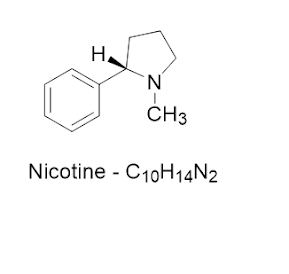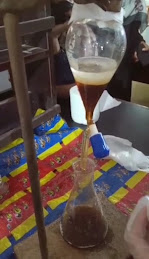Preparation
of p-aminoazobenzene (4-phenylazoaniline) from Aniline
The preparation of p-aminoazobenzene
(4-phenylazoaniline) involves two main steps: the synthesis of diazoamino
benzene (4-diazoanilinobenzene) and its subsequent conversion to
p-aminoazobenzene. Here's a step-by-step outline of the process
Step
1:
Synthesis
of Diazoamino Benzene (4-diazoanilinobenzene)
Theory: The synthesis of diazoamino
benzene involves the conversion of aniline to its diazonium salt, followed by
the reaction of the diazonium salt with an excess of aniline to form the
diazoamino compound.
Chemicals
Required:
- Aniline (C6H5NH2)
- Concentrated hydrochloric acid (HCl)
- Sodium nitrite (NaNO2)
- Ice-cold water
Materials
Required:
- Reaction flask
- Ice bath
- Stirring apparatus
- Filtration setup
- Drying oven
Chemical
Reaction:
Mechanism:
Procedure:
- Start by setting up an ice bath and
placing a reaction flask in it to keep it cold throughout the process.
- In the reaction flask, add 10 mL of
concentrated hydrochloric acid (HCl) and cool the solution in the ice bath.
- In a separate container, dissolve 6.8 g
of sodium nitrite (NaNO2) in 30 mL of water to prepare a sodium
nitrite solution.
- Slowly add the sodium nitrite solution
dropwise to the cold hydrochloric acid solution in the reaction flask, while
stirring continuously. Maintain the temperature below 5°C.
- In another container, prepare a solution
of 7.2 g of aniline in 30 mL of water.
- Slowly add the aniline solution to the
reaction flask containing the diazonium salt solution, while stirring
vigorously.
- Continue stirring the reaction mixture
for about 30 minutes to ensure complete reaction.
- Pour the reaction mixture into a large
volume of ice-cold water to precipitate the diazoamino benzene.
- Collect the precipitate by filtration
and wash it with water to remove impurities.
- Dry the precipitate in a drying oven at
a suitable temperature.
- Weigh the dried diazoamino benzene
product and record its mass for further calculations.


.jpeg)

Calculations:
Aniline (C6H5NH2)
= 7.2 g
Sodium nitrite (NaNO2)
= 6.8 g
First, we need to
determine the limiting reagent by comparing the moles of aniline and sodium
nitrite used:
Molar mass of aniline (C6H5NH2)
= 93.13 g/mol
Molar mass of sodium
nitrite (NaNO2) = 69.01 g/mol
Number of moles of
aniline: mass / molar mass
Moles = 7.2 g / 93.13
g/mol = 0.0774 mol
Number of moles of
sodium nitrite = 6.8 g / 69.01 g/mol = 0.0984 mol
The stoichiometry of
the reaction between aniline and sodium nitrite is 1:1. Since the number of
moles of aniline is lower than the number of moles of sodium nitrite, aniline
is the limiting reagent.
To calculate the
theoretical yield of diazoamino benzene, we'll use the moles of aniline and the
molar mass of diazoamino benzene:
Molar mass of
diazoamino benzene = 181.2 g/mol
Theoretical yield =
Moles of limiting reagent × Molar mass of diazoamino benzene
Theoretical yield =
0.0774 mol × 181.2 g/mol
Theoretical yield = 14.04 g
Therefore, the
theoretical yield of diazoamino benzene, based on the given quantities, is
approximately 14.04 grams.
Step
2: Conversion of Diazoamino Benzene to p-Aminoazobenzene
Theory:
The conversion of diazoamino benzene to
p-aminoazobenzene involves the reaction of diazoamino benzene with aniline
under specific conditions to form the desired product.
Chemicals
Required:
- Diazoamino benzene (from Step 1)
- Aniline (C6H5NH2)
- Sodium hydroxide (NaOH)
- Ethanol (C2H5OH)
Materials
Required:
- Reaction flask
- Ice bath
- Stirring apparatus
- Filtration setup
- Drying oven
Chemical
Reaction:
Mechanism:
Procedure:
- Start by setting up an ice bath and
placing a reaction flask in it to keep it cold throughout the process.
- In the reaction flask, add the
diazoamino benzene obtained from Step 1.
- In a separate container, prepare a
solution of 4 g of aniline in 30 mL of ethanol.
- Slowly add the aniline solution to the
reaction flask containing diazoamino benzene, while stirring continuously.
- Add a solution of 5 g of sodium
hydroxide (NaOH) in 30 mL of water dropwise to the reaction mixture while
maintaining the temperature below 10°C.
- Continue stirring the reaction mixture
for about 30 minutes.
- Pour the reaction mixture into ice-cold
water to precipitate the p-aminoazobenzene.
- Collect the precipitate by filtration
and wash it with water to remove impurities.
- Dry the precipitate in a drying oven at
a suitable temperature.
- Weigh the dried p-aminoazobenzene
product and record its mass for further calculations
Calculations:
Theoretical yield of
diazoamino benzene = 14.04 g
The stoichiometry of
the reaction between diazoamino benzene and aniline to form p-aminoazobenzene
is 1:1. Therefore, the moles of p-aminoazobenzene formed will be equal to the
moles of diazoamino benzene used.
Molar mass of
p-aminoazobenzene = 197.23 g/mol
Theoretical yield of
p-aminoazobenzene = Moles of diazoamino benzene × Molar mass of
p-aminoazobenzene
Moles of diazoamino
benzene = Theoretical yield of diazoamino benzene / Molar mass of diazoamino
benzene Moles of diazoamino benzene
Moles of diazoamino
benzene = 14.04 g / 181.2 g/mol = 0.0774 mol
Theoretical yield of
p-aminoazobenzene = 0.0774 mol × 197.23 g/mol
Theoretical yield of
p-aminoazobenzene = 15.26 g
Therefore, the
theoretical yield of p-aminoazobenzene, based on the given quantities, is
approximately 15.26 grams.






.jpg)
.jpg)
.jpg)
.jpeg)








.jpeg)





.jpeg)
.jpeg)
